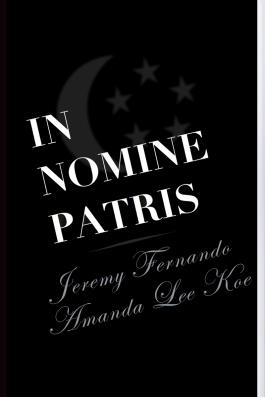“Singapore is our native land, but to be Singaporean is to be your native land. All flesh all action, Harry, make me certain. Make me useful.” (Amanda Lee Koe)
In Nomine Patris … is a collection of written pieces by Singaporeans Jeremy Fernando and Amanda Lee Koe (the question of Singaporean identity is in flux, at least for me). I use the term “pieces” because the collection is stylistically eclectic, denying categorization: fictional non-fiction, poetic, tinged with exposition, seductive epistles never sent, although they have been released, all bound by one man – Lee Kuan Yew, the father of the city-state of Singapore. While Lee Kuan Yew, or Harry, is the focal point of the pieces, they are not really about him, rather, the works are about the authors’ engaging the traces of him that are infused in their Beings, for as Singaporeans produced in the latter half of the 20th Century, the authors are products of Harry, of his imprint on the small island nation, whether they want to be or not.
A perfect crime: one without any victim, except that of the real. Keeping in mind that the real is always already potentially unknowable; at best, we can only catch glimpses of it. And thus: not only always groundless, but more importantly, immortal. Hence, in order to commit this crime, one has to first create what is to be killed. An image: in other words, a sign. (Jeremy Fernando)
The power and control that Lee Kuan Yew wielded over so many aspects of the island’s inhabitants’ lives interests me from a social-engineering perspective; was he not unlike a real life Dr. Moreau trying to construct a Singaporean identity through a hybridization process of cultural traits? Perhaps. Regardless, these two authors are products of his vision; whether he would have been pleased with them or not is his spirit’s business; all I can say is they have written a damn interesting book, not only for Singaporeans and people interested in Singapore, but for anyone interested in contemporary cultures and the effects they have on us.
Fernando and Lee Koe expose and examine reality(s): reality(s) being readings/interpretations of The Real: The Real being that which is before any human interpretation and beyond any certainty of understanding. They know how things work, if not what things are: they know that things come to them always from the already, and always from the unknowable; they know these things form reality(s) that are not The Real, yet it is, can only be, in these reality(s) that the authors exist. Fernando and Lee Koe know that our individual existences are interpretations of shadows: that our worlds cannot be held as absolute. It is as Harold Pinter has been reported as stating in a speech at The National Student Drama Festival in Bristol in 1962:
… there are at least twenty-four possible aspects of any single statement, depending on where you’re standing at the time or on what the weather’s like. A categorical statement, I find, will never stay where it is and be finite. It will immediately be subject to modification by the other twenty-three possibilities of it.
Fernando and Lee Koe offer at least two (perhaps we can find more when rereading their texts) possible reality(s) of Lee Kuan Yew. Everything/everyone is open to interpretation, a different interpretation for every single interpreter. Even the interpreter’s interpretation is “immediately . . . subject to modification.” Thus, there are as many Lee Kuan Yews, Harrys, as there are individuals that know of him.
And these writers, creators, are dangerous to the father. These authors present the reality(s) that they suspect are possible (or is it merely suspect, or surely suspect). Fernando and Lee Koe become Progenitors of a New Singapore for the readers who follow them (and who are of course not lemmings), of a Singapore that unmasks, or is it remasks, the Patris(s), for the Patris that each speaks of, writes of, is not the same for each. The Real can never be known, only perceived/interpreted/read/speculated at/about, so for each reader of the Patris, there is a different Patris because no two readings can be alike.
While her narrator claims to be devoid of satire, Lee Koe, the writer, surely is not. The writer is toying with us. She is coy, and her narrator is toying with the father. An incest of the mind. A Singaporean making love to Singapore, secretly, high above the metropolis, a love-loathing. The narrator, not necessarily the author, writes as a combination of infatuated, stalker-fan, and vengeful lover-daughter. The author is hilarious, must be sitting back with mirth and delight as she revels in the insightful delusions her narrator spins.
Fernando knows that what he writes is not absolute; however, it is a reality, and it is his knowledge of the processes in the phenomenon of understanding that gives him a particular insight into the father of Singapore. I suspect that Fernando reads Lee Kuan Yew as being in a similar position as “the author” in Flann O’Brien’s At Swim Two Birds: that no matter what rules he tries to impose upon them, his characters, his constructions, are going to rebel, are going to go their own way.
Certainly, Fernando and Lee Koe are going their own ways, are not the Singaporeans that Harry had in mind.
Jeremy Fernando and Amanda Lee Koe. In Nomine Patris … London: Pendant Publishing, 2016.
The book can be downloaded for free at: http://www.berfrois.com/in-nomine-patris/
References:
Harold Pinter in John Russel Brown. Theatre Language: A Study of Arden, Osborne, Pinter and Wesker. New York: Taplinger Publishing Company, 1972.
Michael Kearney is the author of numerous articles, reviews, pieces of poetry, and chapters in books, including “Designing Identity: An Attempt to Manufacture Singaporeans,” in The Need to Belong: Perpetual Conflicts and Temporary Stability. Edited by Albin Wagner & Tina Rahimy. Oxford, United Kingdom; Inter-Disciplinary Press: 2015.

